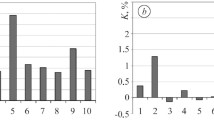We study the influence of the nature of polystyrene modifiers and diester-phthalate plasticizers on the surface hardness, Vicat softening point, degree of release of the plasticizer, and elastoplastic properties of polyvinyl-chloride plastics and their composites. We also discover the influence of polymer-silicate fillers and polystyrene-magnetite materials on the physicomechanical and thermal characteristics of the modified polyvinyl-chloride plastics and determine the conditions of directed regulation of the technological and operating properties of these materials.






Similar content being viewed by others
References
S. G. Patrick, Practical Guide to Polyvinyl Chloride, Rapra Technology Limited, UK (2005).
A. C. Long, Composites Forming Technologies, Woodhead Publ. House, Cambridge (2007).
J. K. Fink, A Concise Introduction to Additives for Thermoplastic Polymers, Wily-Scrivener, Hoboken, Salem (2010).
V. Ye. Levytskyi, D. S. Katruk, A. M. Shybanova, L. M. Bilyi, and T. V. Humenets’kyi, “Physicochemical properties of modified polyester-polyvinylchloride compositions,” Fiz.-Khim. Mekh. Mater., 52, No. 4, 100–105 (2016); English translation: Mater. Sci., 52, No. 4, 559–565 (2017).
M. Xantos, Functional Fillers for Plastics, Wiley-VCH, Weinhem (2010).
D. Katruk, V. Levytskyi, U. Khromyak, V. Moravskyi, and A. Masyuk, “Physicochemical principles of synthesis and modification of unsaturated polyester-polyvinyl chloride composites and the properties of materials derived from them,” Internat. J. Polymer Sci., No. 1, 1–9 (2019); https://doi.org/10.1155/2019/2547384.
V. S. Moravskyi, V. Ye. Levytskyi, A. S. Masyuk, L. M. Bilyi, and T. V. Humenets’kyi, “Influence of modified condensed foamed polystyrene on the morphology and properties of polycaprolactam,” Fiz.-Khim. Mekh. Mater., 54, No. 6, 75–80 (2018); English translation: Mater. Sci., 54, No. 6, 836–842 (2019).
N. U. Imran, A. S. Suhail, and A. Shaheen, “Effect of various additives on the physical properties of poly(vinyl chloride) resin,” Pak. J. Anal. Environ. Chem., 11(2), 44–50 (2010).
Q. Zhou, W. Yang, Q. Wu, B. Yang, J. Huang, and J. Shen, “Modification of polyvinyl-chloride/chlorinated polyethylene blends with ultrafine particles of polystyrene,” Europ. Polymer J., 36 (8), 1735–1740 (2000).
N. N. Tikhonov and B. S. Kirin, “Study of specific features of the modification of polyvinyl chloride by maleated polybutadiene products,” Plastics, 10, 24–28 (2010).
V. Levytskyj, Y. Laruk, T. Humenetsky, and J. Sikora, “The influence of polystyrene modifier and plasticizer nature on the properties of poly(vinyl chloride),” Chem. Chem. Technol., 9, No. 2, 199–203 (2015).
V. E. Levyts’kyi, Yu. V. Laruk, L. M. Bilyi, V. V. Kochubei, and T. V. Humenets’kyi, “Specific features of the modification of polyvinyl chloride with polystyrene plastics,” Fiz.-Khim. Mekh. Mater., 51, No. 3, 83–89 (2015); English translation: Mater. Sci., 51, No. 3, 388–394 (2015).
V. Levytskyi, A. Masyuk, and O. Suberlyak, “Preparation and properties of polymer-silicate composites based on hydrophilic polymers,” Issues Chem. Chem. Technol., No. 6, 68–74 (2017).
V. Mittal, Polymeric Nanocomposites: Advances in Filler Surface Modification Technique, Nova Sci. Publ., New York (2009).
S. R. Tenkayala, M. C. S. Subha, V. R. Gorla, Y. H. Kim, C. R. Kashay, and V. P. Chalapati, “Synthesis and characterization of poly(vinyl alcohol)/water glass (SiO2) nanohybrids via sol-gel process,” J. Appl. Polymer Sci., 117 (6), 3533–3538 (2010).
Author information
Authors and Affiliations
Corresponding author
Additional information
Translated from Fizyko-Khimichna Mekhanika Materialiv, Vol. 57, No. 4, pp. 145–150, July–August, 2021.
Rights and permissions
Springer Nature or its licensor holds exclusive rights to this article under a publishing agreement with the author(s) or other rightsholder(s); author self-archiving of the accepted manuscript version of this article is solely governed by the terms of such publishing agreement and applicable law.
About this article
Cite this article
Masiuk, A.S., Levytskyi, V.E., Katruk, D.S. et al. Physicomechanical Properties of Polyvinyl-Chloride–Polystyrene Plastics. Mater Sci 57, 595–601 (2022). https://doi.org/10.1007/s11003-022-00583-0
Received:
Published:
Issue Date:
DOI: https://doi.org/10.1007/s11003-022-00583-0




